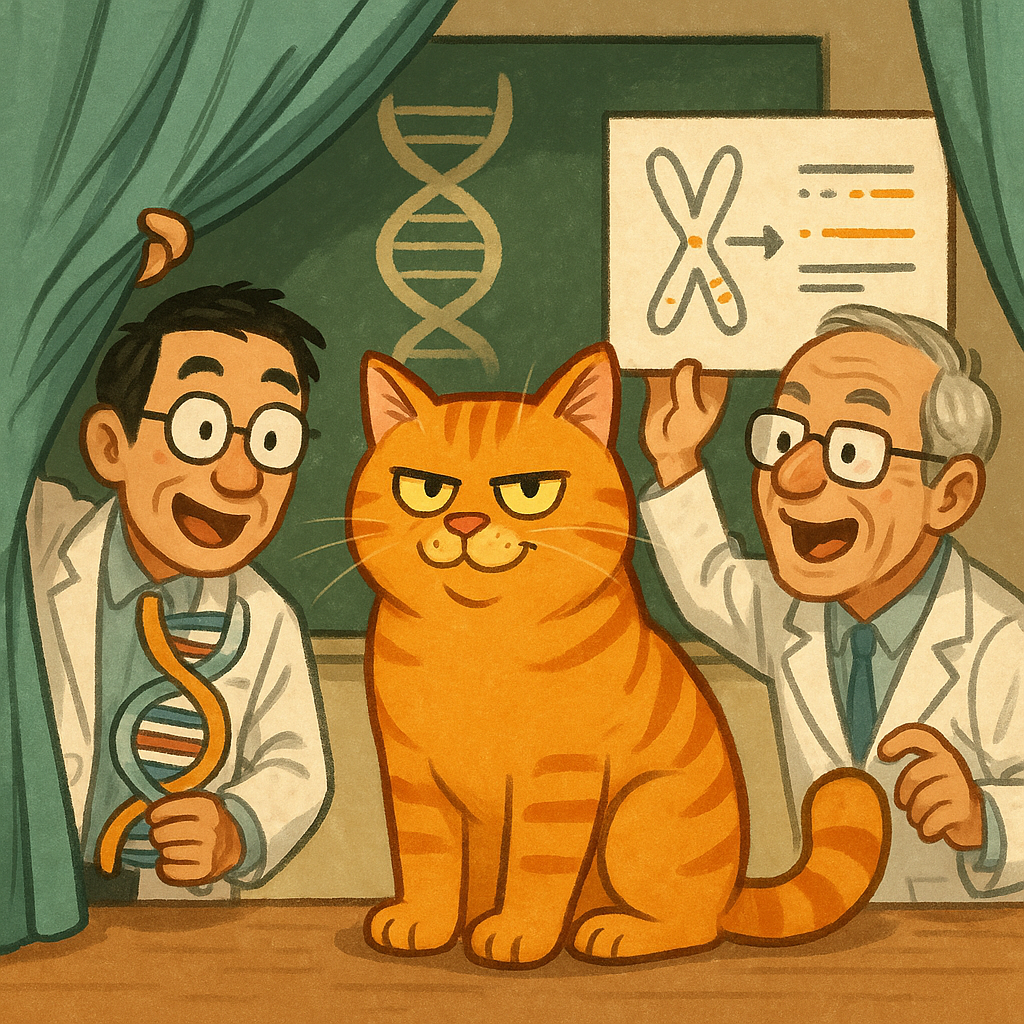A long-standing mystery regarding the genetic basis of ginger cats has recently been unraveled by scientists from Japan and the United States. Iconic characters such as Garfield and Puss in Boots have popularized ginger cats, but the scientific community has struggled to pinpoint the genetic factors responsible for their distinctive orange coloring. Through collaborative research, the teams discovered that ginger cats, particularly males, lack a specific section of their DNA that influences the production of pigments in their skin, eyes, and fur. This breakthrough not only excites researchers but also resonates with the many cat enthusiasts who supported the study through crowdfunding.
For many years, it has been understood that genetics play a crucial role in the coloration of orange tabby cats. However, the precise location of the genetic code responsible for this trait remained elusive until now. The research teams from Kyushu University and Stanford University published their findings simultaneously, revealing that a gene known as ARHGAP36 is significantly more active in the melanocytes, the cells responsible for pigmentation. By comparing the DNA of various cats, they found that those with ginger fur had a missing segment within the ARHGAP36 gene, leading to increased pigment production.
Interestingly, the research also confirmed a long-held observation that ginger cats are predominantly male. This phenomenon is linked to the gene being located on the X chromosome. Male cats possess one X and one Y chromosome, meaning that the absence of the DNA segment on the X chromosome is sufficient to produce a fully ginger coat. In contrast, female cats have two X chromosomes, requiring both to be missing the segment for the same level of pigmentation, which often results in mixed coloring.
The study, while grounded in scientific inquiry, began as a passion project for Professor Hiroyuki Sasaki, who, despite being retired, sought to investigate the genetics of orange cats. His efforts were supported by crowdfunding, raising over 10 million yen from cat lovers who shared his enthusiasm. This collaborative spirit highlights the connection between scientific research and community engagement, as many contributors expressed their desire to support studies that could lead to a better understanding of cat health.
The implications of the ARHGAP36 gene extend beyond fur color; it is also active in various parts of the body, including the brain and hormonal glands. Researchers speculate that mutations in this gene may be linked to other health issues or behavioral traits in cats. While some cat owners believe that coat color influences personality, scientific evidence remains limited. Nonetheless, the findings open new avenues for exploration into the relationship between genetics and feline behavior, promising further insights into the lives of our beloved pets.
Original news source: Decades-long mystery of ginger cats revealed (BBC)
🎧 Listen:
Slow
Normal
Fast
📖 Vocabulary:
| 1 | unraveled | Solved or explained something that was mysterious or complicated |
| 2 | pinpoint | To identify or locate something precisely |
| 3 | distinctive | Having a unique or special quality that makes it stand out |
| 4 | resonates | To produce a strong emotional response or connection |
| 5 | elusive | Difficult to find, catch, or achieve |
| 6 | simultaneously | Occurring at the same time |
| 7 | melanocytes | Cells in the skin responsible for producing pigment |
| 8 | predominantly | Mainly or mostly |
| 9 | phenomenon | An observable event or occurrence, especially one that is unusual or interesting |
| 10 | segment | A part or section of something |
| 11 | inquiry | The act of seeking information or knowledge |
| 12 | crowdfunding | Raising money from a large number of people, typically via the internet |
| 13 | engagement | Involvement or participation in an activity or event |
| 14 | implications | Possible effects or consequences of an action or decision |
| 15 | speculate | To form a theory or conjecture about a subject without firm evidence |
Group or Classroom Activities
Warm-up Activities:
– CHARADES
Instructions: In pairs, students will act out various terms related to the article without using any words. Terms might include “ginger cat,” “genetics,” “crowdfunding,” and “melanocytes.” The rest of the class will guess the term being acted out.
– OPINION POLL
Instructions: Students will discuss their views on whether they believe a cat’s fur color can influence its personality. After a brief discussion, they will take a poll, and the results will be shared with the class.
– MIND MAP
Instructions: In small groups, students will create a mind map that outlines the key points from the article, including the genetics of ginger cats, the role of the ARHGAP36 gene, and the impact of crowdfunding on scientific research. Each group will present their mind map to the class.
– FUTURE PREDICTIONS
Instructions: Students will write down predictions about how this genetic discovery might influence future research in feline health or breeding practices. After writing, they will share their predictions in small groups.
– HEADLINE CREATION
Instructions: Students will brainstorm and create catchy headlines that could be used for a news article about the findings on ginger cats. They will then share their headlines with the class and vote on the most engaging one.
🤔 Comprehension Questions:
1. What discovery did scientists from Japan and the United States make regarding ginger cats?
2. How did the research teams determine the genetic factors responsible for the orange coloring in ginger cats?
3. What is the significance of the ARHGAP36 gene in relation to ginger cats?
4. Why are ginger cats predominantly male according to the article?
5. How did Professor Hiroyuki Sasaki’s research project gain financial support?
6. What connection does the article suggest between the study of ginger cats and community engagement?
7. In addition to fur color, where else is the ARHGAP36 gene active in cats?
8. What potential future research areas are suggested by the findings related to the ARHGAP36 gene?
Go to answers ⇩
🎧✍️ Listen and Fill in the Gaps:
A long-standing mystery regarding the genetic basis of ginger cats has recently been unraveled by scientists from Japan and the (1)______ States. Iconic characters such as Garfield and Puss in Boots have popularized ginger cats, but the scientific community has struggled to pinpoint the genetic factors responsible for their distinctive (2)______ coloring. Through (3)______ research, the teams discovered that ginger cats, particularly males, lack a specific section of their DNA that influences the production of pigments in their skin, eyes, and fur. This breakthrough not only excites (4)______ but also resonates with the many cat enthusiasts who supported the study through crowdfunding.
For many years, it has been understood that (5)______s play a crucial role in the coloration of orange (6)______ cats. However, the precise location of the genetic code responsible for this trait remained elusive until now. The research teams from Kyushu University and Stanford University published their findings simultaneously, revealing that a gene known as ARHGAP36 is significantly more active in the (7)______, the cells responsible for pigmentation. By comparing the DNA of various cats, they found that those with ginger fur had a missing segment within the ARHGAP36 gene, leading to (8)______ pigment production.
Interestingly, the research also confirmed a long-held observation that ginger cats are predominantly male. This phenomenon is linked to the gene being located on the X (9)______. Male cats possess one X and one Y chromosome, meaning that the absence of the DNA segment on the X chromosome is sufficient to produce a fully ginger coat. In (10)______, female cats have two X chromosomes, requiring both to be missing the segment for the same level of pigmentation, which often results in mixed coloring.
The study, while grounded in scientific inquiry, began as a passion project for Professor Hiroyuki Sasaki, who, despite being retired, sought to (11)______ the genetics of orange cats. His efforts were supported by crowdfunding, raising over 10 million yen from cat lovers who shared his enthusiasm. This collaborative spirit highlights the (12)______ between scientific research and (13)______ engagement, as many contributors expressed their desire to support studies that could lead to a better understanding of cat health.
The implications of the ARHGAP36 gene extend beyond fur color; it is also active in various parts of the body, including the brain and (14)______ glands. Researchers speculate that mutations in this gene may be linked to other health issues or behavioral traits in cats. While some cat owners believe that coat color influences personality, scientific evidence remains limited. Nonetheless, the (15)______ open new avenues for exploration into the (16)______ between genetics and feline behavior, promising further insights into the lives of our beloved pets.
Go to answers ⇩
💬 Discussion Questions:
Students can ask a partner these questions, or discuss them as a group.
1. What is your opinion on the role of genetics in determining physical traits in animals?
2. How would you feel if scientists discovered a gene that influenced your own physical appearance?
3. Do you think that the color of a pet’s fur can affect its personality? Why or why not?
4. What is a unique feature of any pet you have owned or known, and how do you think it affects their behavior?
5. How do you feel about crowdfunding for scientific research? Do you think it is a good way to support projects? Why?
6. Do you think that popular culture, like movies or cartoons, influences our perceptions of certain animals, such as cats? Why or why not?
7. What is your experience with pets? Have you ever noticed a difference in personality among pets of different colors or breeds?
8. How would you feel if your favorite pet had a genetic condition that affected its health?
9. Do you think it is important for scientists to engage with the community when conducting research? Why or why not?
10. What is a behavior in animals that you find particularly interesting, and do you think it could be linked to genetics?
11. How do you think advancements in genetics could change the way we care for pets in the future?
12. Do you believe that certain colors in animals are more appealing to people? Why do you think that is?
13. What is a scientific discovery that you think has had a significant impact on society, and why?
14. How would you feel if you learned that your pet’s behavior was influenced by its genetics rather than its environment?
15. Do you think that the relationship between science and community support is essential for successful research? Why or why not?
Individual Activities
📖💭 Vocabulary Meanings:
Match each word to its meaning.
Words:
1. unraveled
2. pinpoint
3. distinctive
4. resonates
5. elusive
6. simultaneously
7. melanocytes
8. predominantly
9. phenomenon
10. segment
11. inquiry
12. crowdfunding
13. engagement
14. implications
15. speculate
Meanings:
(A) Difficult to find, catch, or achieve
(B) Cells in the skin responsible for producing pigment
(C) Occurring at the same time
(D) Having a unique or special quality that makes it stand out
(E) Solved or explained something that was mysterious or complicated
(F) To form a theory or conjecture about a subject without firm evidence
(G) The act of seeking information or knowledge
(H) Mainly or mostly
(I) A part or section of something
(J) Raising money from a large number of people, typically via the internet
(K) To identify or locate something precisely
(L) Possible effects or consequences of an action or decision
(M) To produce a strong emotional response or connection
(N) Involvement or participation in an activity or event
(O) An observable event or occurrence, especially one that is unusual or interesting
Go to answers ⇩
🔡 Multiple Choice Questions:
1. What is the primary focus of the recent research conducted by scientists from Japan and the United States?
(a) The genetic basis of ginger cats
(b) The behavior of all cat breeds
(c) The history of cat domestication
(d) The dietary needs of cats
2. Which gene was found to be significantly more active in ginger cats?
(a) MC1R
(b) TYRP1
(c) ARHGAP36
(d) SLC45A2
3. What was the method of funding for the research project on ginger cats?
(a) Government grants
(b) University funding
(c) Private donations
(d) Crowdfunding
4. What is the reason for the predominance of male ginger cats?
(a) They have a higher birth rate
(b) They are more popular among owners
(c) The gene is located on the X chromosome
(d) They are easier to breed
5. What does the absence of a specific DNA segment in ginger cats lead to?
(a) Increased pigment production
(b) Decreased fur quality
(c) Shorter lifespan
(d) Higher energy levels
6. Who initiated the research into the genetics of orange cats?
(a) A team of graduate students
(b) A private cat breeding organization
(c) A veterinary clinic
(d) Professor Hiroyuki Sasaki
7. What potential implications does the ARHGAP36 gene have beyond fur color?
(a) Influence on dietary preferences
(b) Links to health issues or behavioral traits
(c) Impact on lifespan
(d) Changes in vocalization patterns
8. What was the total amount raised through crowdfunding for the study?
(a) Over 5 million yen
(b) Over 10 million yen
(c) Over 20 million yen
(d) Over 15 million yen
Go to answers ⇩
🕵️ True or False Questions:
1. Male cats have one X and one Y chromosome, allowing them to have a fully ginger coat with just one missing DNA segment.
2. Ginger cats are predominantly female due to the gene being located on the Y chromosome.
3. The research began as a requirement for Professor Hiroyuki Sasaki, who is retired.
4. The ARHGAP36 gene may also be unrelated to other health issues or behavioral traits in cats.
5. Scientists from Japan and the United States have unraveled the genetic basis of ginger cats.
6. The gene ARHGAP36 is significantly more active in the melanocytes of ginger cats.
7. Ginger cats, particularly males, lack a specific section of their DNA that affects pigment production.
8. The study was not supported by crowdfunding, raising over 10 million yen from cat enthusiasts.
Go to answers ⇩
📝 Write a Summary:
Write a summary of this news article in two sentences.
Check your writing now with the best free AI for English writing!
Writing Questions:
Answer the following questions. Write as much as you can for each answer.
Check your answers with our free English writing assistant!
1. What discovery did scientists from Japan and the United States make regarding ginger cats?
2. How does the genetic makeup of ginger cats differ between males and females?
3. What role did crowdfunding play in the research conducted by Professor Hiroyuki Sasaki?
4. What are some potential implications of the ARHGAP36 gene beyond fur color in cats?
5. How might the findings of this study influence future research on feline behavior?
✅ Answers
🤔✅ Comprehension Question Answers:
1. What discovery did scientists from Japan and the United States make regarding ginger cats?
Scientists discovered that ginger cats, particularly males, lack a specific section of their DNA that influences the production of pigments in their skin, eyes, and fur.
2. How did the research teams determine the genetic factors responsible for the orange coloring in ginger cats?
The research teams compared the DNA of various cats and found that those with ginger fur had a missing segment within the ARHGAP36 gene, which is significantly more active in the melanocytes responsible for pigmentation.
3. What is the significance of the ARHGAP36 gene in relation to ginger cats?
The ARHGAP36 gene is significant because it influences pigment production in ginger cats, and its absence leads to the distinctive orange coloring.
4. Why are ginger cats predominantly male according to the article?
Ginger cats are predominantly male because the gene responsible for their coloration is located on the X chromosome, and males have one X and one Y chromosome, allowing them to express the ginger coloration with just one missing DNA segment.
5. How did Professor Hiroyuki Sasaki’s research project gain financial support?
Professor Hiroyuki Sasaki’s research project gained financial support through crowdfunding, raising over 10 million yen from cat lovers who were enthusiastic about the study.
6. What connection does the article suggest between the study of ginger cats and community engagement?
The article suggests that there is a strong connection between scientific research and community engagement, as many contributors to the crowdfunding expressed their desire to support studies that could improve understanding of cat health.
7. In addition to fur color, where else is the ARHGAP36 gene active in cats?
The ARHGAP36 gene is also active in various parts of the body, including the brain and hormonal glands.
8. What potential future research areas are suggested by the findings related to the ARHGAP36 gene?
The findings suggest potential future research areas related to the relationship between genetics and feline behavior, as well as exploring possible links between mutations in the ARHGAP36 gene and other health issues or behavioral traits in cats.
Go back to questions ⇧
🎧✍️✅ Listen and Fill in the Gaps Answers:
(1) United
(2) orange
(3) collaborative
(4) researchers
(5) genetic
(6) tabby
(7) melanocytes
(8) increased
(9) chromosome
(10) contrast
(11) investigate
(12) connection
(13) community
(14) hormonal
(15) findings
(16) relationship
Go back to questions ⇧
📖💭✅ Vocabulary Meanings Answers:
1. unraveled
Answer: (E) Solved or explained something that was mysterious or complicated
2. pinpoint
Answer: (K) To identify or locate something precisely
3. distinctive
Answer: (D) Having a unique or special quality that makes it stand out
4. resonates
Answer: (M) To produce a strong emotional response or connection
5. elusive
Answer: (A) Difficult to find, catch, or achieve
6. simultaneously
Answer: (C) Occurring at the same time
7. melanocytes
Answer: (B) Cells in the skin responsible for producing pigment
8. predominantly
Answer: (H) Mainly or mostly
9. phenomenon
Answer: (O) An observable event or occurrence, especially one that is unusual or interesting
10. segment
Answer: (I) A part or section of something
11. inquiry
Answer: (G) The act of seeking information or knowledge
12. crowdfunding
Answer: (J) Raising money from a large number of people, typically via the internet
13. engagement
Answer: (N) Involvement or participation in an activity or event
14. implications
Answer: (L) Possible effects or consequences of an action or decision
15. speculate
Answer: (F) To form a theory or conjecture about a subject without firm evidence
Go back to questions ⇧
🔡✅ Multiple Choice Answers:
1. What is the primary focus of the recent research conducted by scientists from Japan and the United States?
Answer: (a) The genetic basis of ginger cats
2. Which gene was found to be significantly more active in ginger cats?
Answer: (c) ARHGAP36
3. What was the method of funding for the research project on ginger cats?
Answer: (d) Crowdfunding
4. What is the reason for the predominance of male ginger cats?
Answer: (c) The gene is located on the X chromosome
5. What does the absence of a specific DNA segment in ginger cats lead to?
Answer: (a) Increased pigment production
6. Who initiated the research into the genetics of orange cats?
Answer: (d) Professor Hiroyuki Sasaki
7. What potential implications does the ARHGAP36 gene have beyond fur color?
Answer: (b) Links to health issues or behavioral traits
8. What was the total amount raised through crowdfunding for the study?
Answer: (b) Over 10 million yen
Go back to questions ⇧
🕵️✅ True or False Answers:
1. Male cats have one X and one Y chromosome, allowing them to have a fully ginger coat with just one missing DNA segment. (Answer: True)
2. Ginger cats are predominantly female due to the gene being located on the Y chromosome. (Answer: False)
3. The research began as a requirement for Professor Hiroyuki Sasaki, who is retired. (Answer: False)
4. The ARHGAP36 gene may also be unrelated to other health issues or behavioral traits in cats. (Answer: False)
5. Scientists from Japan and the United States have unraveled the genetic basis of ginger cats. (Answer: True)
6. The gene ARHGAP36 is significantly more active in the melanocytes of ginger cats. (Answer: True)
7. Ginger cats, particularly males, lack a specific section of their DNA that affects pigment production. (Answer: True)
8. The study was not supported by crowdfunding, raising over 10 million yen from cat enthusiasts. (Answer: False)
Go back to questions ⇧













